

How is Rausch shampoo actually made?
Rausch herbal shampoo is a firm fixture on pharmacy shelves. I visited the long-running Swiss company to take a closer look at the manufacturing process – from the idea to the finished bottle.
The busy main road with its constant roar is only a few metres away, yet it’s completely absorbed by the idyll. Lush green stretches around me, peppered with colourful flowers busily circled by bees. Everything seems natural – and yet it’s clear that a lot of work and subtlety goes into this oasis.
I’m standing in the middle of Rausch AG's herb garden, a 2,000 square metre area immediately behind the company building. In my hometown of Kreuzlingen on Lake Constance, the established Swiss company has been producing hair and body care products from herbs for 133 years. This is where they develop and make their products and then market them worldwide. «The garden is where we grow local herbs and flowers, which we use for research and development purposes. Some of them even end up in the production facility because they have to be processed fresh. The green space also serves as a space for employees to relax, where they can help themselves to fruit and vegetables,» explains Silvia Banz. She’s the Key Account Manager at Rausch and takes care of e-commerce in the European market.

Source: Christian Walker
Looking back
Our tour begins in the past. More precisely, in the in-house mini museum. A large glass display case contains a number of bottles and tinctures. They’re witnesses to days gone by and demonstrate how the recipes and design of Rausch products have changed over the years.
The company was founded by German master hairdresser Josef Wilhelm Rausch in 1890. Back then, many of Rausch’s customers were suffering with hair loss. As a result, he developed his first hair tonic, an herbal tincture to combat this. The herbal shampoo came later, and the company is still known for it today. What many people don’t know is that Rausch actually invented liquid shampoo. By the way, the hair tincture is still available to buy, obviously adjusted to today’s regulatory and quality standards. «It’s our longest-lasting product and is particularly popular in the Arab market,» says Silvia.
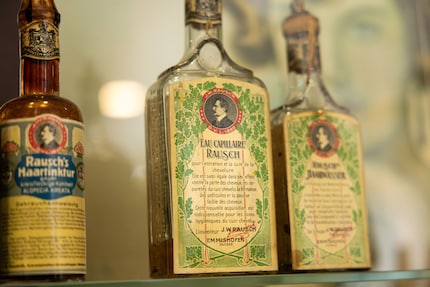
Source: Christian Walker

«We develop our shampoos with a solution-oriented approach. This means that we offer products for different concerns. Coltsfoot for dandruff, heart seeds for a sensitive scalp, aronia for those first grey hairs and so on,» explains Sales Manager Barbara Banzhaf. I think back with nostalgia to the seaweed shampoo in our shower when I was a child and the mini version I always took with me to swimming lessons in my gym bag. At the time, I didn’t really care that the seaweed extract it contained was supposed to help with an oily scalp. I was convinced that mermaids would use it too. After all, it has seaweed in it. But it’s a long journey from the seaweed or herb to the finished shampoo in my gym bag. And I’ll be taking a closer look at that today.
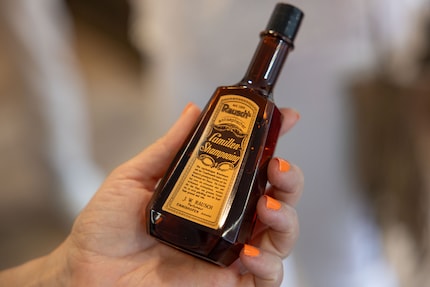
Source: Christian Walker
The ideas factory
Lab Manager Fabienne Wach welcomes us to the research and development laboratory. This is where new extracts, colours and scents are tested and compatibility and durability tests are carried out. Fabienne works on new products using herbal ingredients and looks at how existing products can be improved.
New product ideas are created in close collaboration with the marketing and field sales teams. «Sometimes raw material suppliers even come to us with active ingredient trends,» explains Fabienne. Once the team has agreed on an idea, they have to define what the product must be able to do. Based on this, they create a surfactant mixture as a base. «This is tailored to the care needs that the product should meet. That’s why every shampoo has a different composition,» adds Fabienne.
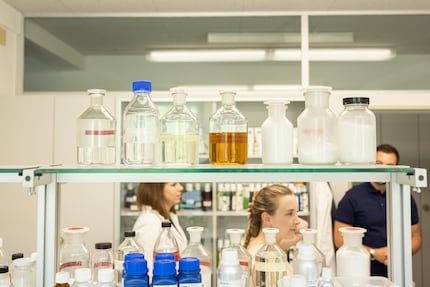
Source: Christian Walker
This is where the plants come in. «For damaged hair, for example, we use plants with moisturising properties or various oils. The appropriate colour will be developed in the next step. We then write to perfume houses and tell them what kind of scent we have in mind.» The same briefing produces completely different scent samples. Fabienne’s team selects three from this pool to add to the shampoo. They then distribute the samples to 30 people with matching hair types to evaluate their feedback.
Once the recipe is in place, it’s followed by effectiveness studies and various tests for stability and tolerability. «We subject every product that comes onto the market to a stability test. This means that it’s stored in a warming cabinet at 40° Celsius for three months and then checked,» Fabienne explains. The process of making shampoo – which the team already has a lot of expertise in – can take a year from idea to production. For new products, it can sometimes take two years.
Older generations mainly know Rausch for its anti-lice remedy, a product that they no longer make due to regulatory changes. «Only pharmaceutical companies are allowed to make it now,» explains Sales Manager Barbara. «What we still have, however, is a shampoo that protects against lice infestation. This is particularly popular with parents who use it to wash their children’s hair.» But how does it actually work?
«This is where the willow bark it contains comes into play,» explains Fabienne, head of the development department. «Lice don’t like willow bark. In order to determine whether prevention with a willow bark shampoo actually has a significant effect, shampoo bottles were distributed to various school classes over the decades. The study showed that children who washed their hair with the product regularly were less likely to be infested with lice.» The effect comes primarily from the willow bark scent. «Lice hate the smell. But people do too,» laughs Fabienne. Yes, the scent takes some getting used to, but if it helps…
Despite containing over 90 per cent natural ingredients, Rausch products are not certified as natural cosmetics. «That was a conscious decision,» says Barbara. «Our products contain as much nature as possible without sacrificing effectiveness or tolerability.» Fabienne adds: «a natural cosmetics certification would have the disadvantage for us that we would have to rely purely on essential oils to perfume our products. This has a higher allergy potential.» According to Fabienne, perfume compositions consist of around 70 to 100 substances. These may also include essential oils. «However, the advantage of perfume over an essential oil is that we can simply remove the allergens from the perfume compositions.»
The herb storeroom
As we enter the storage room, the aromatic scent of tea hits my nose. In front of us there are rows of shelves stacked with large, flat bags. The raw materials that Rausch purchases from external suppliers are temporarily stored here before being further processed into the extract. Mainly in dried form, with the exception of a few fresh plants, such as nettles.
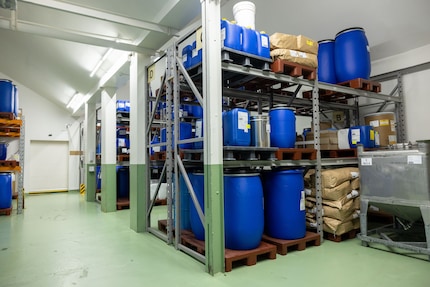
Source: Christian Walker
«We try to source as many of the herbs as possible from the region and Switzerland. We also work closely with foragers. These are people who look for specific wild herbs for us,» says Silvia. «We source a few raw materials from abroad, such as ginseng and seaweed, mainly from Eastern Europe. Unfortunately, not all raw materials can be grown in Switzerland without sacrificing quality. This is partly because the soil here doesn’t provide the necessary nutrients.»
Extraction
The extract from the herbs is obtained in the percolation room. The herbal extracts are then pre-produced, stored and later processed into shampoo as required. Dzeljalj Kazimi, Head of Quality Control, is responsible for ensuring that everything runs smoothly. Leaves, flowers, bark, roots and even whole plants are processed as part of the in-house process, using an extractant that gently removes the active ingredients from the plants.
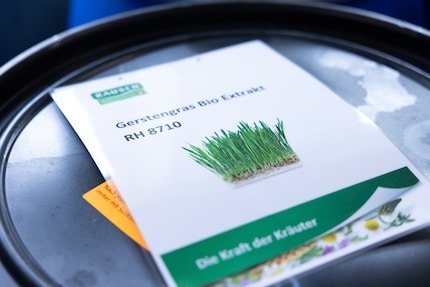
Source: Christian Walker
To kill all germs, the extracts are pasteurised, circulating for four hours at 80° Celsius. The heat kills microorganisms, allowing the extract to be stored for up to two years. «Some of the extracts also have to go through a natural ripening process so that they don’t have a negative impact on the stability of the product. However, there are various ways to shorten or even avoid this entirely,» explains Dzeljalj. Depending on the extract, the manufacturing process takes two to five days. «The extracts – which have a maturation period of ten to 12 months, are tricky. That’s an organisational challenge.» Every year, between 45 and 50 tonnes of pure, liquid herbal extract are produced here in 500 and 800-litre tanks. Exactly how much extract is in a single bottle of shampoo is a secret. «But I’ll say this much: it’s a lot.»
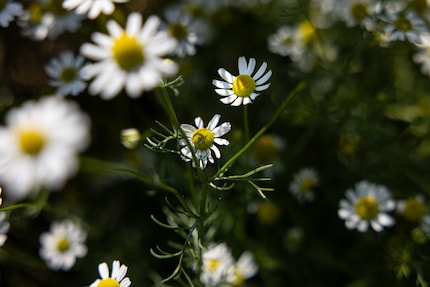
Source: Christian Walker
Production
Jens Brünisholz, a cheerful and strikingly likeable guy, manages production and is one of three people who work in this area. He shows us around the shampoo cellar. «There’s not much going on today, the cleaning programme is running,» he explains. At Rausch, only one type of shampoo (depending on conditioner or hair tonic) is produced at a time in batches. The machines then have to be cleaned for a day before production of the next product can begin. Approximately one million litres of product are produced in the shampoo cellar each year across all product categories.
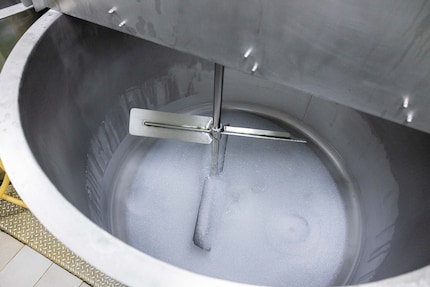
Source: Christian Walker
«This is usually where the base for the conditioner comes from,» says Jens, pointing to two vats. «The larger one is where the aqueous phase is heated, while the fat – e.g. shea butter – is melted in the smaller one. To mix both phases at all, we need a homogeniser. This ensures that water and oil can be mixed into an emulsion. The herbal extract is then added.» The procedure for making shampoo is different: «we mix all the raw materials, including extracts and surfactants, together in a cold state, all according to our recipe.» According to Jens, all shampoo formulas can be produced within a day. The company produces 4,000 kilogrammes per day.
The shampoo doesn’t go straight to the bottling plant once it’s been mixed. «Every single batch of shampoo undergoes a microbiological check in our laboratory over several days. This enables us to eliminate germs,» says Jens. Once the quality check is complete, the shampoos are either stored or connected via a hose system to the filling system one floor above us. That’s where we’re heading next.
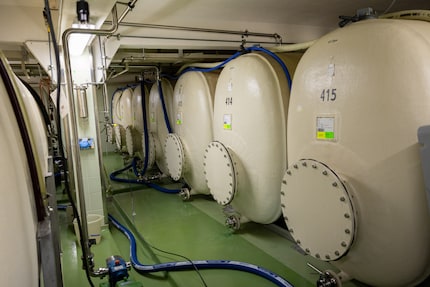
Source: Christian Walker
The bottling plant
We’re right at the heart of the action. At least that’s how Raoul Munari, Head of Intralogistics, describes his bottling plant. The bottles are filled, sealed and labelled under his watchful eye. Depending on the machine, they can fill up to 10,000 to 20,000 bottles per day.
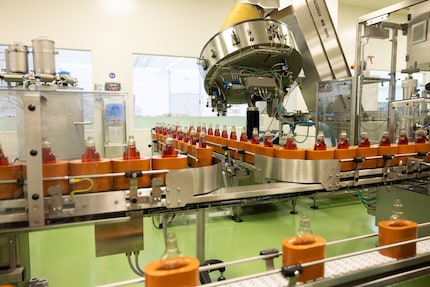
Source: Christian Walker
There are two types of production, he explains. «We produce in stock for core countries such as Switzerland and its neighbouring countries. For export, for example to Asia or Arab countries, we produce to order.» So that processing export orders doesn’t take too long, they produce what they call semi-finished products. «These are filled bottles with the production date printed on them and the only thing missing is the appropriate label. This is adapted to the respective country.» It’s an expensive process that creates the flexibility the team relies on due to limited physical space.
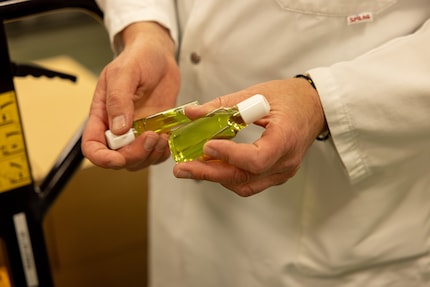
Source: Christian Walker
What sounds like a popcorn machine in the background is the lid system. The white plastic caps are poured into a lane, where they run over a turntable which separates the lids and then leads them to the slightly yellowed-looking bottles. «A year ago we switched to rPET – recycled PET – which gives the bottle a yellow tint,» explains Silvia, as Raoul shows us around the system. «This makes the bottle look older than it is, which caused confusion among our customers. We’re often asked why the shampoo is suddenly a different colour. Then we explain that it’s just the packaging. We haven’t changed anything about the formula.»
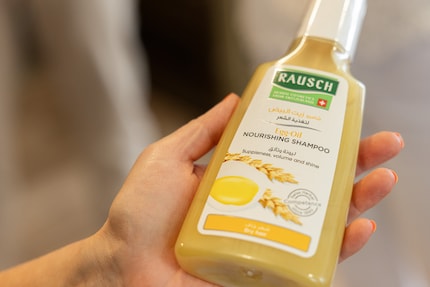
Source: Christian Walker
The labelling machine applies front and back labels as well as the batch code. A camera checks whether the labels are positioned correctly. «In the past, each bottle was checked individually. Fortunately, a camera system takes care of this now. But every 15 minutes we check again with a calliper – a kind of template – to make sure the labels are actually in the middle. If not, they have to go back,» says Raoul.
After the bottles have been filled by the machine, sealed with a lid and labelled, they’re checked manually from all sides one last time. Then they set off on their journey to distant countries, to the local pharmacy shelf – or to the Galaxus warehouse.
Header image: Christian Walker
As a massive Disney fan, I see the world through rose-tinted glasses. I worship series from the 90s and consider mermaids a religion. When I’m not dancing in glitter rain, I’m either hanging out at pyjama parties or sitting at my make-up table. P.S. I love you, bacon, garlic and onions.
Interesting facts about products, behind-the-scenes looks at manufacturers and deep-dives on interesting people.
Show allThese articles might also interest you
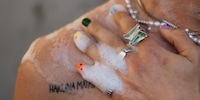
Background information
«99.9 per cent of shower gels labelled as 'soap' don’t contain soap»
by Natalie Hemengül

Background information
A visit to farfalla: essential oils from around the world
by Anna Sandner

Background information
Baccarat Rouge 540: from luxury collector’s item to darling of the masses
by Natalie Hemengül
